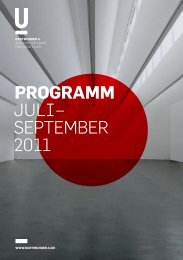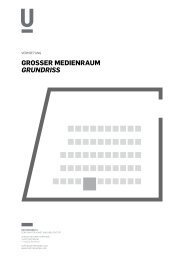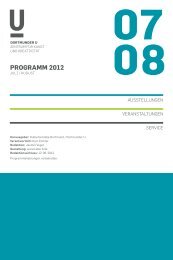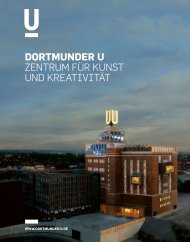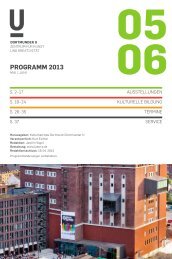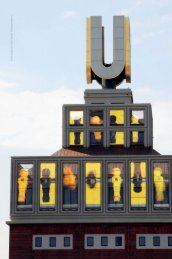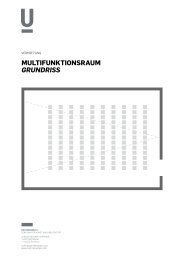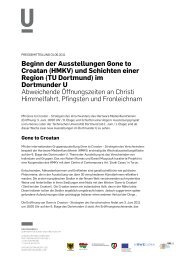dortmunder u CENTRE FOR ART AND CREATIVITY
dortmunder u CENTRE FOR ART AND CREATIVITY
dortmunder u CENTRE FOR ART AND CREATIVITY
Create successful ePaper yourself
Turn your PDF publications into a flip-book with our unique Google optimized e-Paper software.
32<br />
JOURNEY INTO THE U<br />
FLYING PICTURES BY<br />
ADOLF WINKELMANn<br />
Anna Tüne<br />
A FILM INSTALLATION<br />
IN THREE STATIONS<br />
FIRST STATION<br />
U-TOWER PICTURE CLOCK<br />
Film artist Adolf Winkelmann has transformed the<br />
U-Tower into a picture clock, reminiscent of baroque<br />
church towers with their ingenious moving mechanisms.<br />
The digital revolution has meant that moving<br />
pictures have long taken off from cinema and television,<br />
and now fly freely from laptops to mobile phones and<br />
around our cities. For the film-maker it was therefore<br />
only a small intellectual step to his staging of the<br />
old storage tower of the Dortmunder Union Brewery.<br />
Winkelmann illuminates the tower’s unique rooftop<br />
with film images. The observer looks into the building’s<br />
interior as though through a gauze, which is more or<br />
less transparent, depending on the weather, the season<br />
and the light conditions, indeed different from minute<br />
to minute. Winkelmann creates the sense of a space<br />
behind the colonnades and fills it with life, with imaginary<br />
water or with beer. Every hour on the hour it is<br />
inhabited by large pigeons. As a secular church tower<br />
the U-Tower is intended to give signs of light, signs<br />
of life, sketch silhouettes of human motion onto the<br />
sky above the Ruhr.<br />
SECOND STATION<br />
RUHR PANORAMAS IN THE ENTRANCE HALL<br />
On eleven screens suspended above the visitors’ heads,<br />
Winkelmann shows associatively assembled panoramas,<br />
his map of the Ruhr Metropolis. It is a stream of<br />
images of documentary views, taken in many locations<br />
in the Ruhr area. The incredible precision, the almost<br />
machine-perfect gliding of the panoramas is a carefully<br />
and accurately created effect made possible by highly<br />
specialized technology. Sometimes the camera eye<br />
follows, with an unshakeable steadiness, the profiles<br />
of façades made of stone, glass, plastic and plaster<br />
around a narrow town square, unutterably and movingly<br />
ordinary; sometimes it leads us to believe in its<br />
freedom and scans the panorama of a slag heap, only<br />
to be confronted with the feeling that it is precisely this<br />
freedom that cannot be found; but always the precisely<br />
created aesthetic of the chain of images confronts the<br />
viewer with an undeniable experience of highly objective<br />
reality. The grave material present is garishly illu mi -<br />
nated. Nevertheless, the visitor is embraced by the<br />
stream of pictures, which complement each other, fall<br />
apart like the image in a kaleidoscope and then recreate<br />
themselves in the next moment into great, moving<br />
panoramas. The factuality of these outside worlds is<br />
boosted into a hyper-reality which is difficult to repress.<br />
THIRD STATION<br />
NINE WINDOWS IN THE VERTICAL <strong>ART</strong> SPACE<br />
The film staging continues in the stairwell, making<br />
even a ride on the escalator an experience. The<br />
installation invites the visitor to explore the museum<br />
storeys or to have a look at the creative workshops.<br />
Nine virtual image windows open up on the vertical<br />
art space’s internal wall. They take the form of small<br />
square holes in the concrete, facing outwards or<br />
inwards, over three storeys. These image windows<br />
are the stage setting for the people of the Ruhr, for<br />
their attitude to life, their desire, their language. The<br />
authenticity of this part of the installation rests<br />
wholly on personal encounters with people who have<br />
influenced Winkelmann’s life and world view; he is<br />
involved here in an intimate sense: rigorously and<br />
subjectively, even autobiographically, implicated. As<br />
a film-maker he has, more than almost anyone, given<br />
the Ruhr a new face while remaining affectionately<br />
disposed towards its traditional character. He always<br />
does this in a respectful way, while also playing with<br />
individual clichés. He draws his figures – as clownesque<br />
and creative, fit for everyday life but also drawn<br />
towards the magic of the surreal, both difficult and<br />
easy – with a completely unpretentious compassion.<br />
Left: Nine Windows in the vertical art space<br />
Right: U-Tower Picture Clock<br />
Bottom: Ruhr Panoramas in the Entrance Hall<br />
Photos: © Adolf Winkelmann<br />
Created by Adolf Winkelmann<br />
Script department: Jost Krüger<br />
Camera: David Slama, Voxi Bärenklau<br />
Sound compositions: Hans-Peter Kuhn,<br />
Hans Steingen<br />
Sound design: Matthias Lempert<br />
Production: Christiane Schaefer<br />
With: Dietmar Bär, Peter Fitz, Stephan Kampwirth,<br />
Peter Lohmeyer, Jürgen Mikol, Caroline Peters,<br />
Irene Rindje, Benjamin Sadler, Jürgen Schornagel,<br />
Christian Tasche, Margret Völker,<br />
Katharina Wackernagel, August Zirner<br />
Winkelmann Filmproduktion GmbH for the<br />
City of Dortmund © 2010



